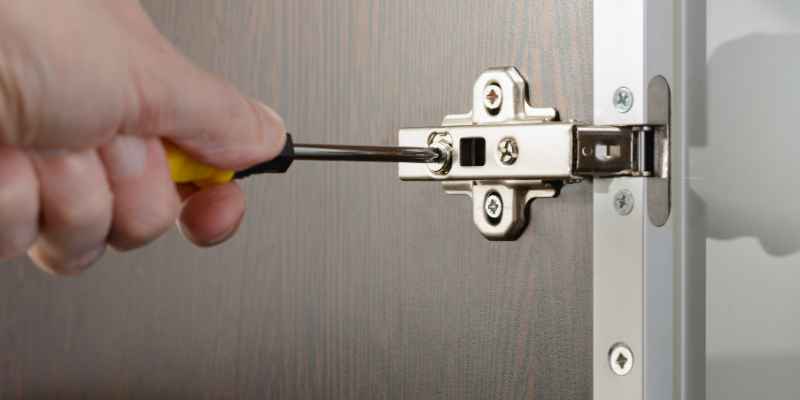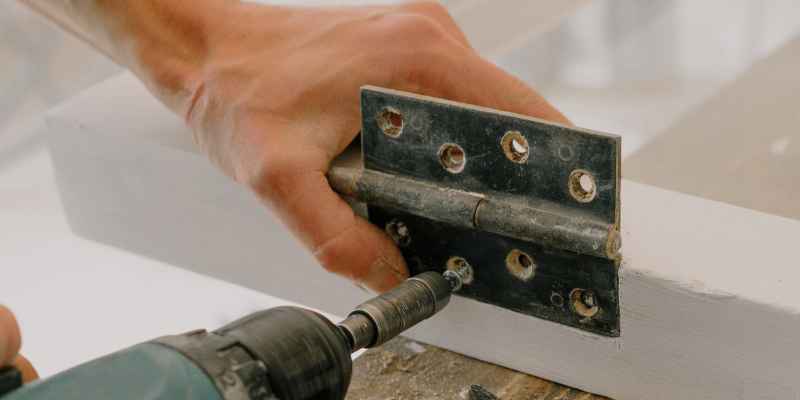A hinge works by connecting two objects, allowing them to pivot or rotate. It consists of two plates, joined by a pin, which allows the objects to move relative to each other.
Hinges are a fundamental mechanical component used in various applications, from doors and cabinets to car doors and laptop screens. They provide stability and enable smooth opening and closing of objects, while also providing support and maintaining alignment. The basic functioning of a hinge involves an axial rotation, where one plate remains stationary while the other moves.
This movement is facilitated by the pin, which acts as a pivot point. The plates are typically designed with a series of holes or knuckles to hold the pin securely in place. Different types of hinges exist, such as butt hinges, continuous hinges, and barrel hinges, each with its unique design and applications. However, they all work on the principle of allowing rotational movement between two objects. A hinge is a simple yet essential mechanism that enables the movement and rotation of objects. Its seamless operation contributes to the functionality and usability of numerous everyday items.
An Introduction To Hinges
Hinges play a crucial role in allowing doors and cabinets to open and close smoothly. They work by using two metal plates connected by a pin or rod, enabling rotational movement. The design of hinges ensures stability and reinforced support for various objects.
When it comes to the functioning of doors and cabinets, hinges play a crucial role. A hinge is a mechanical device that enables the opening and closing of a door or a lid. It acts as a pivot point and allows smooth movement, ensuring the stability and security of various structures.
Types Of Hinges
There are various types of hinges available, each serving different purposes. Some of the common types include:
- Butt Hinge: This is the most common type, consisting of two rectangular metal plates joined by a pin. It is primarily used for doors and cabinets.
- Continuous Hinge: Also known as a piano hinge, this type runs the full length of the door or lid, providing continuous support. It is popular in decorative applications.
- Concealed Hinge: Designed to be hidden when the door is closed, this hinge offers a seamless and aesthetically pleasing appearance.
- European Hinge: Widely used in modern cabinetry, this hinge is fully adjustable and provides a clean and sleek look.
- Overlay Hinge: These hinges are visible when the door is closed and are commonly used in cabinet doors.
- Barrel Hinge: Consisting of a rotating cylinder attached to a frame, this hinge offers a high weight-bearing capacity and is often seen in heavy-duty applications.
Basic Components Of A Hinge
A hinge typically consists of several key components that allow it to function effectively. These components include:
- Leaf Plates: Also called flap plates, these are the flat, elongated parts that attach to the door or cabinet.
- Knuckle: The cylindrical section of a hinge that connects the leaf plates.
- Pins: These cylindrical rods help to connect the knuckles and allow the hinge to rotate smoothly.
- Bushings: Positioned inside the knuckles, bushings reduce friction and ensure smooth movement.
- Screws: Used to secure the hinge to the door or cabinet, screws are an essential component to provide stability.

Understanding The Mechanics Of A Hinge
A hinge is a fundamental component of many everyday objects that we use without giving it much thought. From doors and cabinets to laptops and cars, hinges play a crucial role in allowing things to move and rotate smoothly. In this article, we will delve into the mechanics of a hinge, exploring its pivot point and rotation, as well as its load-bearing capacity.
Pivot Point And Rotation
At the heart of every hinge is the pivot point, which acts as the central axis around which the hinge rotates. This pivot point is usually composed of a pin or rod that fits into a corresponding socket or bracket, allowing the hinge to swivel or swing in one or more directions.
When a hinge opens or closes, it undergoes rotational motion. This rotation can be either in a single plane, such as with a door hinge, or in multiple planes, as seen in some specialized hinges like those found in certain furniture or machinery.
Depending on the specific hinge design, the rotation can be limited to a certain range, preventing overextension or providing additional stability. For example, cabinet hinges often have a 90-degree range of motion, allowing the door to swing open only as far as intended.
Load Bearing Capacity
Another important aspect of hinges is their load-bearing capacity. This refers to the amount of weight and pressure that a hinge can support without becoming damaged or compromised. The load-bearing capacity of a hinge is determined by various factors, including the materials used, the size and design of the hinge, and the distribution of weight along the hinges.
Hinges designed for heavy-duty applications, such as industrial machinery or large gates, typically have a higher load-bearing capacity compared to those used in lighter objects like cabinets or jewelry boxes.
To ensure optimal performance and longevity, it is crucial to choose a hinge with a load-bearing capacity that matches the intended use and the expected weight and stress it will encounter.
In conclusion, hinges are indispensable in allowing objects to move and rotate smoothly. Understanding the mechanics of a hinge, including its pivot point and rotation, as well as its load-bearing capacity, can help us appreciate the intricate engineering behind these seemingly simple devices.
Different Applications Of Hinges
When it comes to the functionality and versatility of hinges, their applications go far beyond just doors. Hinges are crucial components in various different industries and sectors, contributing to the smooth and efficient movement of objects. Let’s take a closer look at some of the different applications of hinges and how they work in each scenario.
Door Hinges
Door hinges are perhaps the most common and widely recognized application of hinges. They play a vital role in allowing doors to swing open and closed smoothly, while also providing stability and support to the door. Door hinges are designed to withstand the repetitive motions of opening and closing, ensuring durability and longevity.
In residential settings, door hinges are used on interior and exterior doors, as well as on various furniture pieces like cabinets and closets. In commercial settings, door hinges are found in office buildings, hospitals, hotels, and retail establishments.
Cabinet Hinges
Cabinet hinges are specifically designed for use on cabinets, providing the necessary functionality and convenience to access stored items. These hinges allow cabinet doors to swing open and close smoothly, allowing for easy retrieval of items and efficient storage.
Cabinet hinges come in various types and styles, including butt hinges, concealed hinges, and European hinges, each offering different benefits and features. Butt hinges, for example, offer strength and stability, while concealed hinges provide a sleek and modern appearance.
Gate Hinges
Gate hinges are essential for the smooth operation of gates, allowing for easy opening and closing. These hinges are typically designed to handle heavier loads and withstand constant outdoor exposure to weather conditions.
Gate hinges can be found in various settings, including residential properties, farms, industrial facilities, and public spaces. They are commonly used on garden gates, driveway gates, and security gates, providing both security and convenience.
Automotive Hinges
Automotive hinges are used extensively in the automotive industry to enable the movement of various parts and components. These hinges contribute to the functionality of doors, hoods, trunks, and other movable parts in vehicles.
Automotive hinges are designed to withstand the constant stress and vibration experienced while driving, ensuring a secure and reliable operation. They are crucial for the safety and functionality of vehicles, providing smooth opening and closing movements.
From doors to cabinets, gates to automotive parts, hinges play a vital role in numerous applications across various industries. Understanding how hinges work and their different applications can help us appreciate the importance of these simple yet essential hardware components.
Innovations In Hinge Designs
Hidden Hinges
Hidden hinges, also known as concealed hinges, are a marvel of engineering that have gained popularity in recent years. As the name suggests, these hinges are hidden from view when cabinets, doors, or furniture pieces are closed, giving them a sleek and seamless appearance. The absence of visible hardware on the exterior enhances the overall aesthetics, perfect for modern and minimalist designs.
These hinges are often installed within the interior of the door or cabinet, creating a flush look without any protruding parts. They can be used for both inset and overlay doors, offering flexibility in design. Hidden hinges are adjustable, allowing users to fine-tune the door’s alignment for a perfect fit. With their sleek appearance and adjustable functionality, hidden hinges are the go-to choice for those seeking a contemporary and streamlined look.
Self-closing Hinges
Self-closing hinges are another revolutionary innovation that has made our lives easier. These hinges are designed with a mechanism that automatically closes the door or cabinet once it reaches a certain angle. This eliminates the need to manually close the door, providing convenience and ensuring that doors are never left open unintentionally.
Self-closing hinges are commonly used in household cabinets, kitchen cabinets, and even some interior doors. They are especially useful in areas where doors need to remain closed to maintain privacy or prevent drafts. With their self-closing mechanism, these hinges enhance safety by reducing the risk of doors swinging open unexpectedly.
Moreover, self-closing hinges also assist in preventing wear and tear. Doors with these hinges close gently, reducing the impact and minimizing the chances of slamming or damaging the door or the frame. This ultimately prolongs the lifespan of the doors, cabinets, or furniture pieces, making self-closing hinges a reliable and practical choice.

Maintaining And Troubleshooting Hinges
Proper maintenance and timely troubleshooting can go a long way in ensuring the smooth functioning of hinges. Whether you have hinges on your doors, cabinets, or other moving parts, understanding how to keep them in good condition will prevent unnecessary squeaking, sticking, or even breakage. In this section, we will discuss two crucial aspects: lubrication and cleaning, as well as fixing common issues that may arise with hinges.
Lubrication And Cleaning
Regular lubrication is essential to keep hinges functioning properly. Over time, dust, dirt, or debris can accumulate in the hinge mechanism, leading to stiffness and difficulty in movement. Here are some key points to consider when it comes to lubrication and cleaning:
- Choose the right lubricant: Before applying any lubricant, make sure to select one that is suitable for your specific hinge type. This can include options like silicone spray, machine oil, or graphite powder.
- Clean the hinge: Start by removing any visible dirt or grime from the hinge using a soft brush or cloth. Make sure to pay attention to the entire hinge surface, including the pin and the area beneath it.
- Apply lubricant: Once the hinge is clean, apply a small amount of lubricant to the pin and the pivot points. Be careful not to use excessive amounts as this can lead to drips and messiness.
- Operate the hinge: After lubrication, open and close the hinge several times to distribute the lubricant evenly and ensure smooth movement. If there is still stiffness or resistance, consider applying more lubricant and repeating the process.
Fixing Common Issues
Despite proper maintenance, hinges may still encounter some issues. Here are a few common problems that can occur and how to fix them:
| Issue | Fix |
|---|---|
| Squeaking sound: | Apply a small amount of lubricant to the affected area, focusing on the pivot points. |
| Sticking or jamming: | Inspect the hinge for any visible obstructions or debris, and clean or remove them as necessary. If the issue persists, consider adjusting the hinge tension or seeking professional help. |
| Looseness: | Check the screws holding the hinge in place and tighten them if necessary. If the screws are stripped, replace them with longer or wider screws for better grip. |
| Hinge misalignment: | Inspect the hinge and door or cabinet frame to ensure they are properly aligned. If misalignment is detected, adjust the hinge position or seek professional assistance if needed. |
By following these guidelines for lubrication, cleaning, and troubleshooting, you can ensure that your hinges remain in optimal condition for years to come. Regular maintenance will not only improve the functionality of your hinges but also extend their lifespan, saving you from the hassle and cost of replacement. Remember, a well-maintained hinge is a key component of a well-functioning door or cabinet.
Conclusion
From the simple design to the intricate mechanics, understanding how a hinge works is essential in various fields. With its ability to provide flexibility and stability, hinges are the unsung heroes that allow doors, windows, and other objects to move smoothly.
By comprehending the art of their design and functionality, we unlock endless possibilities for innovation and improvement. Embrace the power of hinges and unlock new doors in your own endeavors. Exciting discoveries await!


